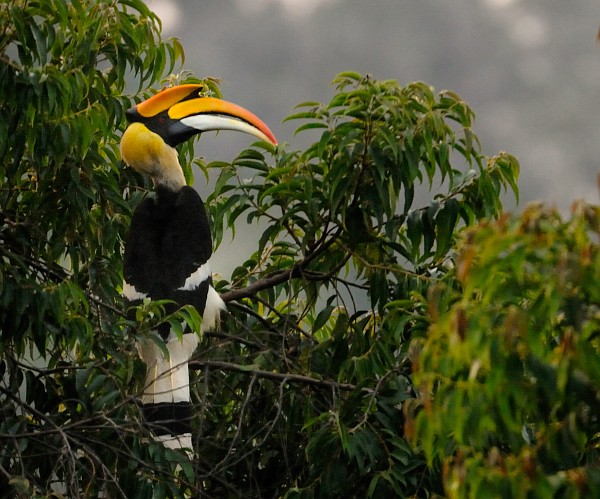Great Hornbill
A species of Large Asian Hornbills, Also known as Great Pied Hornbill Scientific name : Buceros bicornis Genus : Large Asian Hornbills
Great Hornbill, A species of Large Asian Hornbills
Also known as:
Great Pied Hornbill
Botanical name: Buceros bicornis
Genus: Large Asian Hornbills
Content
Description People often ask General Info
 Photo By Kalyanvarma , used under CC-BY-SA-3.0 /Cropped and compressed from original
Photo By Kalyanvarma , used under CC-BY-SA-3.0 /Cropped and compressed from original Description
The great hornbill is a large bird, 95–130 cm (37–51 in) long, with a 152 cm (60 in) wingspan and a weight of 2 to 4 kg (4.4 to 8.8 lb). The average weight of 7 males was 3 kg (6.6 lb) whereas that of 3 females was 2.59 kg (5.7 lb). It is the heaviest, but not the longest, Asian hornbill (falling second to the similarly weighted helmeted hornbill due to the latter's extremely long tail feathers). Females are smaller than males and have bluish-white instead of red eyes, although the orbital skin is pinkish. Like other hornbills, they have prominent "eyelashes". The most prominent feature of the hornbill is the bright yellow and black casque on top of its massive bill. The casque appears U-shaped when viewed from the front, and the top is concave, with two ridges along the sides that form points in the front, whence the Latin species epithet bicornis (two-horned). The back of the casque is reddish in females, while the underside of the front and back of the casque is black in males. The casque is hollow and serves no known purpose, although it is believed to be the result of sexual selection. Male hornbills have been known to indulge in aerial casque butting, with birds striking each other in flight. The male spreads the preen gland secretion, which is yellow, onto the primary feathers and bill to give them the bright yellow colour. The commissure of the beak is black and has a serrated edge which becomes worn with age. The wing beats are heavy and the sound produced by birds in flight can be heard from a distance. This sound has been likened to the puffing of a steam locomotive starting up. The flight involves stiff flaps followed by glides with the fingers splayed and upcurled. They sometimes fly at great height over forests. 
Size
1.05 m
Colors
Black
Yellow
White
Life Expectancy
33 years
Nest Placement
Cavity
Feeding Habits
Great Hornbill predominantly consume fruit such as figs and lipid-rich varieties; they also eat small mammals, birds, reptiles, and insects. Foraging involves hopping on branches and tossing prey in the air before swallowing.
Habitat
Great Hornbill primarily inhabits dense, old-growth forests in hilly and mountainous regions, with a preference for unlogged, primary evergreen forests. These regions broadly encompass tropical and subtropical areas of the Indian subcontinent and Southeast Asia, reaching elevations of up to 2000 meters. They require large continuous stretches of habitat, evident from their extensive home ranges. Great Hornbill may occasionally traverse open areas to move between forest patches but are highly dependent on expansive forested landscapes for survival.
Dite type
Frugivorous
People often ask
General Info
Feeding Habits
Bird food type

Fruit
Distribution Area
Great hornbills are found in the forests of India, Bhutan, Nepal, Mainland Southeast Asia, Indonesian Island of Sumatra and North eastern region of India. The distribution of the species is fragmented over its range in the Indian subcontinent and Southeast Asia. In the subcontinent they are found in a few forest areas in the Western Ghats and in the forests along the Himalayas. Deforestation has reduced their range in many parts of India such as in the Kolli hills where they were recorded in the 1860s. Their distribution extends into Thailand, Burma, Malaya, and Sumatra. A small feral population is found in Singapore. Their habitat is dense old growth (unlogged) forests in hilly regions. They appear to be dependent on large stretches of forest, unlike many of the smaller hornbills. In Thailand the home range of males was found to be about 3.7 km during the breeding season and about 14.7 km during the non-breeding season. 
Species Status
Due to habitat loss and hunting in some areas, the great hornbill is evaluated as vulnerable on the IUCN Red List of Threatened Species. (uplisted from near threatened in 2018). It is listed in Appendix I of CITES. Declines in population have been noted in many areas such as Cambodia. In Southeast Asia, birds are frequently shot at by poachers who mistake the species for the highly sought-after helmeted hornbill. Molecular approaches to the study of their population diversity have been attempted. 